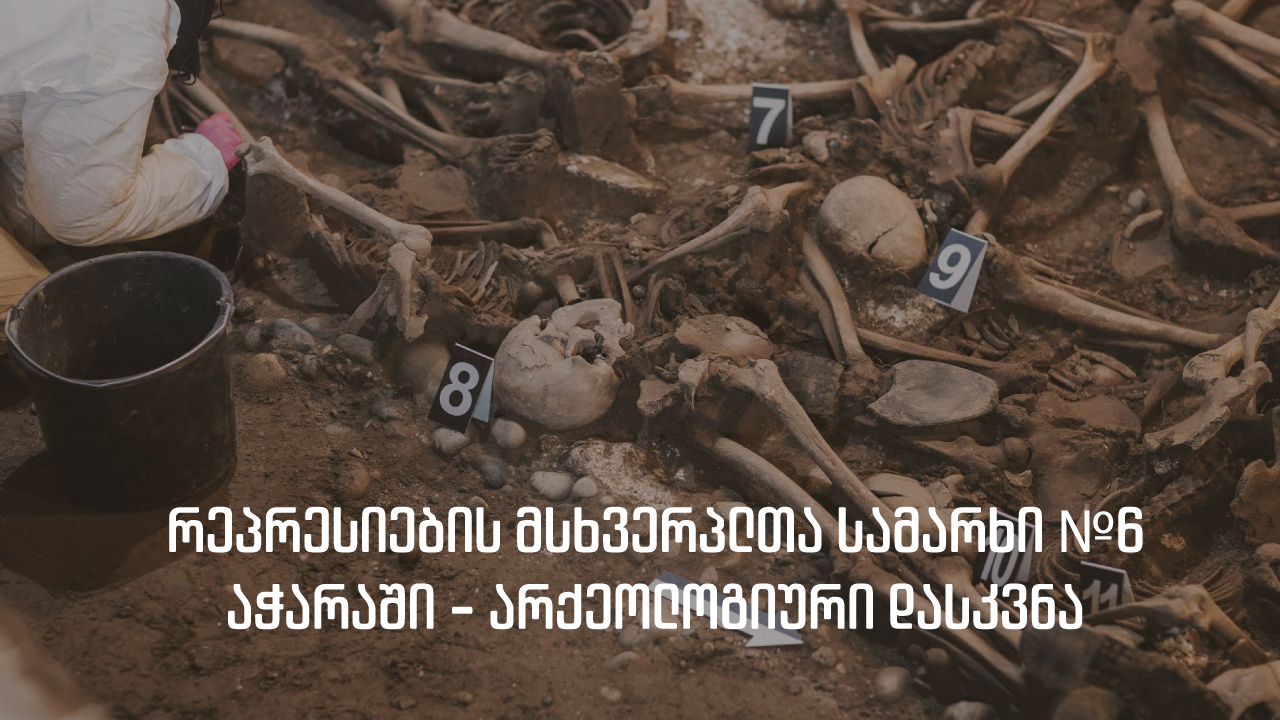On February 9, 2022, Polish Institute of National Remembrance (IPN) completed the process of exhumation in Adjara and the mass grave №6 of the victims of the Great Terror of 1937-1938. In October 2022, IPN provided a completed study - Archaeological report on the exhumation and search work carried out at the military base No. 3 in Batumi, Khelvachauri, Pridon Khalvashi Av. 338, Autonomous Republic of Adjara, Georgia on January 24 - February 8, 2022. In this article, the main findings of the study are presented.
Earlier this year, in January-February, IDFI oversaw further excavations at the Soviet era military base no. 3 in Khelvachauri, Adjara. At this now (mostly) inactive military base, a number of mass graves had been found, containing the bodies of victims of the 1937-38 Communist purges, and excavations had uncovered 5 graves before this latest project. With the collaboration of the diocese of Batumi and Lazeti, IDFI invited a team of Polish archaeologists, affiliated with the Institute of National Remembrance (IPN), to begin excavations on the 6th grave, in which it was assumed 30 victims would be found. Previously, the remains of approximately 178 people had already been uncovered, due to firstly the efforts of Mother Sidonia Darchia; and later on, collaboration with Texas and Michigan State universities.
Despite adverse weather conditions, the 6th pit was ready for excavations, due majorly to the erection of a shed over the not yet excavated grave, shielding it from the worst of the weather. Work thus began promptly. Indeed, the bottom part of the pit had been uncovered, which again allowed excavations to begin with greater ease. All of this had been already established in a preliminary investigation of the site the previous summer; conducted by the Office of Search and Investigation (BPil) team, Anton Vacharadze of IDFI, and the Mother Superior on behalf of the diocese of Batumi and Lazeti. Some changes were made nonetheless. Due to the ongoing threat of rain and snow, drainage ditches were built, and the already existing shed was converted into a larger structure, making it easier to work.
The exhumation of the remains found in the pit was the immediate priority of the excavating team - this process being in alignment with IDFI’s goals of transparency surrounding the fates of repressed individuals. In the end, 29 skeletons were unearthed, all with common characteristics. All of the victims were found with their hands tied behind their backs, though the actual binding had decomposed since it was likely made out of string or something of that ilk. In addition, every victim had skull injuries that point to shooting as the method of execution. In most cases this injury was as explicit as an obvious gunshot wound. However, even in cases where this was lacking, the remainder of the victims had perimortem skull injuries - which are likely to have been caused by gunshot wounds. The exact method of the execution, beyond the fact that it was carried out by gunshot, is slightly more ambiguous. It is unlikely that all the victims were executed on the edge of the pit because of the manner in which their bodies have been arranged. Yet, in the pit itself, rounds of 9mm ammunition were found (amongst a variety of objects) suggesting perhaps the victims were executed individually. A number of them may have been executed in the pit, on top of others who had already been buried. No exact conclusion can be found.
Beyond the skeletons, 226 artefacts, or fragments of artefacts, belonging, most likely to the victims, were also found in the pit. The majority of these artefacts were fragments of clothing (such as belt buckles) that had not decomposed, but some personal objects were found amongst them. A pair of dentures was noted, as well as combs, and coins etc all of which are in storage, having been cleaned appropriately. Of the artefacts, some clearly belong to individual victims; whereas the archaeological team has noted that others (for example, shoes) appear to have been hurled into the pit post execution. The later addition of items of clothing may suggest that the victims were searched, and had shoes removed, prior to their execution, objects which were then tossed into the pit afterwards.
Fascinatingly, layers of agglomerated lime were observed at the top of the pit, and in between the skeletons. The archaeological team noted that it was a common misconception of this era that lime would lead to total decomposition - yielding no evidence of any crimes committed against these victims. Thus we can observe, yet again, a snapshot into the Soviet process of disposing of victims and attempting to entirely erase their bodies and thus any memory of them. This unsuccessful attempt to conceal history is being directly counteracted by the principles of transparency, and discovery of victims and their stories, upheld not only by IDFI but also the IPN in this recent excavation. Indeed, the site at Khelvachauri is of serious significance, as the first of its kind discovered in Georgia, thus far.
The Full Study.
Excavations were held with the financial support of the Swedish International Development Cooperation Agency, Sida.






